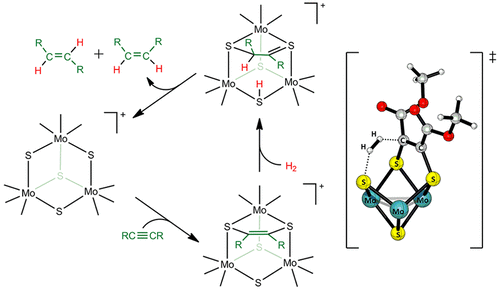当前位置:
X-MOL 学术
›
ACS Catal.
›
论文详情
Our official English website, www.x-mol.net, welcomes your feedback! (Note: you will need to create a separate account there.)
Cuboidal Mo3S4 Clusters as a Platform for Exploring Catalysis: A Three-Center Sulfur Mechanism for Alkyne Semihydrogenation
ACS Catalysis ( IF 12.9 ) Pub Date : 2018-07-09 00:00:00 , DOI: 10.1021/acscatal.8b02254 Andrés G. Algarra 1 , Eva Guillamón 2 , Juan Andrés 2 , M. Jesús Fernández-Trujillo 1 , Elena Pedrajas 2 , Jose Ángel Pino-Chamorro 1 , Rosa Llusar 2 , Manuel G. Basallote 1
ACS Catalysis ( IF 12.9 ) Pub Date : 2018-07-09 00:00:00 , DOI: 10.1021/acscatal.8b02254 Andrés G. Algarra 1 , Eva Guillamón 2 , Juan Andrés 2 , M. Jesús Fernández-Trujillo 1 , Elena Pedrajas 2 , Jose Ángel Pino-Chamorro 1 , Rosa Llusar 2 , Manuel G. Basallote 1
Affiliation

|
We report a trinuclear Mo3S4 diamino cluster that promotes the semihydrogenation of alkynes. Based on experimental and computational results, we propose an unprecedented mechanism in which only the three bridging sulfurs of the cluster act as the active site for this transformation. In the first step, two of these μ-S ligands react with the alkyne to form a dithiolene adduct; this process is formally analogous to the olefin adsorption on MoS2 surfaces. Then, H2 activation occurs in an unprecedented way that involves the third μ-S center, in cooperation with one of the dithiolene carbon atoms. Notably, this step does not imply any direct interaction between H2 and the metal centers, and directly results in the formation of an intermediate featuring one (μ-S)–H and one C–H bond. Finally, such half-hydrogenated intermediate can either undergo a reductive elimination step that results in the Z-alkene product, or evolve into an isomerized analogue whose subsequent reductive elimination generates the E-alkene product. Interestingly, the substituents on the alkynes have a major impact on the relative barriers of these two processes, with the semihydrogenation of dimethyl acetylenedicarboxylate (dmad) resulting in the stereoselective formation of dimethyl maleate, whereas that of diphenylacetylene (dpa) leads to mixtures of Z- and E-stilbene. The results herein could have significant implications on the understanding of the catalytic properties of MoS2-based materials.
中文翻译:

立方Mo 3 S 4团簇作为探索催化的平台:炔烃半氢化的三中心硫机制
我们报告三核Mo 3 S 4二氨基团簇,促进炔烃的半氢化。根据实验和计算结果,我们提出了一种前所未有的机制,其中只有簇中的三个桥联硫充当该转化的活性位点。第一步,这些μ-S配体中的两个与炔烃反应形成二硫代烯加合物;该过程在形式上类似于烯烃在MoS 2表面上的吸附。然后,H 2的活化以前所未有的方式发生,涉及到第三个μ-S中心,并与二硫代碳原子之一结合在一起。值得注意的是,该步骤并不意味着H 2之间存在任何直接相互作用。以及金属中心,直接导致形成具有一个(μ-S)–H和一个C–H键的中间体。最后,这种半氢化的中间体可以经历还原消除步骤以产生Z-烯烃产物,或演变成异构化的类似物,其随后的还原消除产生E-烯烃产物。有趣的是,炔烃上的取代基对这两个过程的相对壁垒有重大影响,其中乙炔二羧酸二甲酯(dmad)的半氢化作用导致顺丁烯二酸二甲酯的立体选择性形成,而二苯乙炔(dpa)的立体选择性形成Z的混合物-和E-二苯乙烯。本文的结果可能对理解基于MoS 2的材料的催化性能具有重要意义。
更新日期:2018-07-09
中文翻译:

立方Mo 3 S 4团簇作为探索催化的平台:炔烃半氢化的三中心硫机制
我们报告三核Mo 3 S 4二氨基团簇,促进炔烃的半氢化。根据实验和计算结果,我们提出了一种前所未有的机制,其中只有簇中的三个桥联硫充当该转化的活性位点。第一步,这些μ-S配体中的两个与炔烃反应形成二硫代烯加合物;该过程在形式上类似于烯烃在MoS 2表面上的吸附。然后,H 2的活化以前所未有的方式发生,涉及到第三个μ-S中心,并与二硫代碳原子之一结合在一起。值得注意的是,该步骤并不意味着H 2之间存在任何直接相互作用。以及金属中心,直接导致形成具有一个(μ-S)–H和一个C–H键的中间体。最后,这种半氢化的中间体可以经历还原消除步骤以产生Z-烯烃产物,或演变成异构化的类似物,其随后的还原消除产生E-烯烃产物。有趣的是,炔烃上的取代基对这两个过程的相对壁垒有重大影响,其中乙炔二羧酸二甲酯(dmad)的半氢化作用导致顺丁烯二酸二甲酯的立体选择性形成,而二苯乙炔(dpa)的立体选择性形成Z的混合物-和E-二苯乙烯。本文的结果可能对理解基于MoS 2的材料的催化性能具有重要意义。



























 京公网安备 11010802027423号
京公网安备 11010802027423号